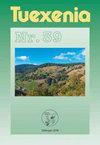东匈牙利的Solonetz草甸植被(Beckmannion eruciformis) -由水分和盐度驱动的联盟
IF 1.1
4区 生物学
Q3 PLANT SCIENCES
引用次数: 41
摘要
湿草甸是湿地与干中温草地之间的过渡生境;因此,它们作为物种扩散的来源、垫脚石和绿色走廊,对维持生物多样性至关重要。尤其适用于高景观尺度斑块性典型的内陆碱地植被,植被类型之间频繁发生快速转换。Solonetz草甸(Beckmannion eruciformis)是欧洲保存最完好的开放栖息地之一,拥有独特的植物群,包括几种特有植物。除了它们的重要性之外,对solonetz草甸植被的研究很少,尽管这些知识对其有效保护和管理至关重要。利用自己的记录和文献数据,我们提供了一个联盟的综合,以表征其在东匈牙利Tisza河沿岸的五个地区的区系和生态协会。我们研究了三个联盟:(i)匍匐茎农-草甘膦(alopecuretum pratensis), (ii)匍匐茎农-鹰钩藤(beckmannietum eruciformis)和(iii)匍匐茎农-甘油三酯(glycerietum pedi-cellatae)。结果表明,青草草甸群落沿水分梯度分布,干燥端为匍匐茎-枯秃根,湿端为匍匐茎-甘油三酯。植物社会学类群的分布也证明了这种梯度是合理的。在匍匐茎-青叶-草皮-甘油三酯中,羊茅-溴酸类所占比例最高,而在匍匐茎-甘油三酯中,莎草-芦苇类所占比例最高。在匍枝草-绿枝草群落中,小叶草-水杨草所占比例最高,表明该群落土壤盐分较高。研究结果表明,匍匐茎-草头枯枯菌的结合力在保护周围干旱草原的大陆植物区系要素方面起着重要作用。土壤水分和盐度生态指标值表明,土壤湿度随海拔高度的降低而增加,而盐度在中等海拔高度最高。我们的研究结果表明,匍匐茎-绿beckmannietum eruciformis是一个向盐沼过渡的群落,而匍匐茎-甘油三酯是一个向淡水沼泽过渡的群落。研究结果表明,草甸在维持景观尺度物种和生境多样性方面具有重要作用,在湿地周围具有缓冲带的作用,是自然保护的重要任务。本文章由计算机程序翻译,如有差异,请以英文原文为准。
Solonetz meadow vegetation (Beckmannion eruciformis) in East-Hungary – an alliance driven by moisture and salinity
Wet meadows are transitional habitats between wetlands and dry-mesophilous grasslands; thus, they are vital in sustaining biodiversity as sources, stepping stones and green corridors of species dispersal. It is especially valid for inland alkali vegetation, where high landscape-scale patchiness is typical and rapid shifts between vegetation types occur frequently. Solonetz meadows (Beckmannion eruciformis) are among the best-preserved open habitats in Europe harbouring a unique flora including several endemics. Besides their importance, studies on the vegetation of solonetz meadows are scarce even though this knowledge would be vital for their effective conservation and management. Using own records and literature data, we provide a synthesis of the alliance Beckmannion eruciformis to charac-terise its associations floristically and ecologically in five regions along the river Tisza, East Hungary. We studied three associations of the alliance: (i) Agrostio stoloniferae-Alopecuretum pratensis, (ii) Agrostio stoloniferae-Beckmannietum eruciformis and (iii) Agrostio stoloniferae-Glycerietum pedi-cellatae. We found that solonetz meadow associations were separated along a moisture gradient with Agrostio stoloniferae-Alopecuretum pratensis at the drier end and Agrostio stoloniferae-Glycerietum pedicellateae at the wet end. This gradient was also justified by the distribution of the phytosociological groups. The proportion of species of Festuco-Brometea division was the highest in Agrostio stolonifer-ae-Alopecuretum pratensis, while the proportion of Cypero-Phragmitetea species was the highest in Agrostio stoloniferae-Glycerietum pedicellateae. Species of Puccinellio-Salicornetea had the highest proportion in Agrostio stoloniferae-Beckmannietum eruciformis, indicating the high soil salinity of this association. Our results suggest that Agrostio stoloniferae-Alopecuretum pratensis association plays an important role in preserving the continental flora elements of the surrounding dry grasslands. The ecological indicator values for soil moisture and salinity suggest that in case of the studied solonetz meadow associations, humidity increases with decreasing elevation, while salinity is highest at medium elevations. Our results suggest that Agrostio stoloniferae-Beckmannietum eruciformis is a transition towards salt marsh associations, while Agrostio stoloniferae-Glycerietum pedicellatae is a transition towards freshwater marshes. Our results show that preserving solonetz meadows is an important task for nature conservation as they have a crucial role in maintaining landscape-scale species and habitat diversity and act as buffer zones around wetlands.
求助全文
通过发布文献求助,成功后即可免费获取论文全文。
去求助
来源期刊

Tuexenia
PLANT SCIENCES-
CiteScore
2.80
自引率
25.00%
发文量
0
期刊介绍:
Tuexenia publiziert Original- und Übersichtsarbeiten sowie Berichte zu Themen der Geobotanik / Vegetationsökologie und zu Nachbarwissenschaften wie Populationsökologie, Biodiversitätsforschung, Biozönologie, Renaturierungsökologie und ihren Anwendungen, vor allem im Naturschutz. Der geografische Schwerpunkt liegt in Zentraleuropa und angrenzenden Regionen.Tuexenia erscheint jährlich in einem Band, der etwa zur Jahresmitte fertig gestellt wird. Autoren erhalten von jeder Arbeit eine PDF-Datei und gemeinsam 20 Sonderdrucke kostenlos.
Die Qualität der wissenschaftlichen Manuskripte wird durch die Redaktion und einen Wissenschaftlichen Beirat (Peer Review) gesichert (s. auch die Manuskript-Richtlinien vor dieser Seite). Es werden keine Druckkosten erhoben. Tuexenia legt Wert auf allgemeine Online-Verfügbarkeit der Beiträge.
 求助内容:
求助内容: 应助结果提醒方式:
应助结果提醒方式:


